Feasibility and Economic Impacts of the Energy Transition
Abstract
:1. Introduction
2. Materials and Methods
2.1. The Macroeconomic Model
2.1.1. Main Features
2.1.2. Mathematical Formulation
- , , , and refer to the production, capital stock, EIC, and NEIC of sector i, respectively. Energy production and consumption are measured in units of energy (); good production, NEIC, and capital stock in units of good produced by the FS ().
- , , and refer to the capital, EIC, and NEIC intensities of sector i, respectively, i.e., the quantities of these inputs per unit of output. These intensities are likely to change over time as technologies evolve.
2.2. The Energy Model
2.3. Articulation between the Two Models
2.4. Allowable Space and Transition Curve
2.4.1. Allowable Space
2.4.2. Transition Curve
2.4.3. The Reduced Dynamic Model
- Exercise 1: s and fixed.
- Exercise 2: and fixed.
2.5. Calibration of the Macroeconomic Model
- Sectoral capital depreciation rates. Based on the literature, the lifetime of capital in the ES is estimated at 25 years, and that in the FS at 20 years. This gives and .
- The share of total capital devoted to the ES, as measured by the ratio . The calibration of the GEMBA model [16] provides the value μ =6.5%.
- The share of energy expenditure in the total household and state budget measured by (Equation (19)). On the basis of the OECD input-output tables, an estimate of 4% is found for 2015.
- Figure 4a shows that the capital intensity increases considerably with the penetration rate : , which is consistent with the common assumption that renewable energies are much more capital intensive than non-renewable energies.
- Figure 4b shows that increases slightly with the ET: . The NEIC requirements are not much higher for renewable energies than for non-renewable energies.
- Because and , the energy intensity slightly decreases with (Figure 4c).
2.6. Future Evolution of the Parameters
- The evolution of the technical parameters of the ES with the ET is described by Equations (21)–(23), where the technical parameters of the non-renewable energy subsector are assumed to be constant and equal to their calibrated value in 2018 (see Table 2). Assuming that the parameters of the non-renewable energy subsector will not change in the future can be considered to be optimistic. Given the maturity of the technologies, technological progress seems to be limited and not able to counterbalance the depletion of the resources. It is therefore likely that in the future there will be an increase in the energy and capital intensities of the non-renewable energy subsector.
- Based on past values, the parameters and are assumed to be constant. Indeed, the MM calibration performed over the last 30 years shows that these parameters have not changed since 1990 (see Appendix E).
- The changes in and are based on the IEA’s "World Energy Outlook” 2020 report [25]. There are two scenarios: (i) the business-as-usual scenario (BAU), where changes in and are extrapolated on the basis of the last 30 years (by 2040, increases by 45% and decreases by 15%) and (ii) the sustainable development scenario (SD), which assumes a constant energy demand and a rapidly decreasing energy intensity in the coming decades (by 2040, would decrease by 40%, which corresponds to a rate of decline never observed in the past) (see Appendix F for further details). In the long term, both of the scenarios have the same technical progress potential in the FS ( is asymptotically reduced by 50%), the difference between the two scenarios being the pace at which this limit is reached. A third scenario based on the IEA’s New Policies scenario was also tested, but did not lead to fundamentally different results from those of the BAU scenario.
3. Results
3.1. Exercise 1—s and η Given
3.1.1. Impact of
- Figure 5a gives the value of the penetration rate in 2100. The curve is slightly increasing, but is approaching 30% at best.
- Figure 5b shows that the ET is never completed in a finite time. Nevertheless, we see that is approaching 1 for , and is above 65% for all values of . The non-completion of the ET is due to the fact that the growth rate of the capitak stock decreases down to zero.
- As mentioned above, the residual growth rate of the capitak stock is 0 for all the simulations. The economy tends towards a stationary state with no growth.
- Figure 5a shows that the renewable penetration rate in 2100 is significantly higher for SD than for BAU.
- Figure 5b shows that, if no scenario allows for a complete ET in a finite time.
- Figure 5c shows that for the duration of the ET decreases with (from 248 years for to 131 years for ). The minimum value of is reached for (a complete transition by 2149).
- Figure 5d shows that the residual capital growth rate is 0 for and sightly increasing for . At best, it reaches 0.056%.
3.1.2. Impact of the Technical Progress Rate
3.2. Exercise 2— and Fixed
3.2.1. Impact of
- The ET is completed in a finite time for and and, thus, for all values of . is slightly increasing with , but it varies little ( goes from 2129 for to 2133 for ). In Exercise 1, an increase of stimulated capital growth and, thereby, accelerated the ET. In Exercise 2, this effect is not present, since is fixed.
- The ET is far from being completed by the end of the century. varies between 46% for and 17% for .
- As for , the observed values of s at the end of the ET evolve little with (from 44% for = 0 to 41% for = 1).
- The previous intuition is confirmed, since the completion of the ET is obtained after a period of 67 to 72 years, i.e., a value of around 2090.
- Maintaining the capital growth rate during the ET requires a significant increase in the savings rate s. However, this increase is less than for BAU, as s reaches between 37 and 40% at the end of the ET, depending on the value of .
3.2.2. SD: Required for
- increases slightly with , from 2.91% to 3.12%.
- The savings rate that was observed at the end of the ET decreases slightly with , while still remaining above 40%.Note: similar simulations can be carried out within the framework of BAU. To complete the transition by 2070, a capital growth rate of around 4.1% is required, depending on . To maintain this growth rate, a savings rate of more than 55% is then necessary (s at the end of the ET decreases from 58.6% for to 56.2% for ).
3.2.3. Temporal Analysis
- Unsurprisingly, the ET results in a significant increase in the real price of energy p (Figure 6d). Despite the decrease of due to technical progress, the growth of the economy results in an increased demand for energy, which pushes up its price. At the end of the ET, the price p reaches six times its initial value. This results contradicts the one of Jacobson [4], claiming that the price of energy will not increase with the ET.
- The rise in the price of energy translates into a significant increase in the share of the ES gross added value in GDP (), as shown in Figure 6e. The increase in the share of the ES net added value in NDP (as measured by ) is more moderate.
- Figure 6f illustrates the evolution of the FS production (), as well as how it is distributed between final consumption , investment I, and intermediate consumption deliveries to the two sectors . While final output remains growing during the transition, there is a decline in the growth of consumption of goods , which, like C, is almost constant at the end of the ET. In other words, because of the increase in the savings rate, the allocation of changes to the detriment of and to the benefit of I (the share of the intermediate consumption deliveries remaining almost constant).
- The increase in s translates into a slowdown in aggregate consumption C with respect to GDP. C becomes quasi-stationary at the end of the ET, while the economy is still growing (Figure 7a).
- Figure 7b illustrates how the ES production is split between self-consumption , deliveries to the FS , and final energy consumption . It can be observed that the share of in increases significantly to the point of taking up most of the energy production at the end of the ET.
- The ET is accompanied by a strong increase in , the ES capital intensity. As the share of capital in the economy that is devoted to this sector continues to grow, the capital intensity of the economy, which is defined as , increases (Figure 7c).
- In Appendix G, we show that the GDP growth is decomposed into the growth of the capital stock and the decline in the capital intensity of the economy (defined as ): . Given the previous observation (v is increasing), the GDP growth rate declines despite the constancy of , as confirmed by Figure 7d.
- Figure 7e illustrates the decrease in the ratios (where denotes the total output of the economy, including all intermediary consumptions) and during the ET. The decrease in the first ratio indicates that the ET results in a faster growth of the intermediary consumptions as compared to GDP (the end-use consumption). The decrease of the second ratio is linked to the increase in the share of capital consumption in GDP, which is induced by the increase in capital intensity v (the increase of v outweighs the decrease of , the latter being due to the fact that the life span of capital is higher in the ES than in the FS). The share of useful production (i.e., for consumption or growth) in total production tends to decrease with the ET.
- Figure 7f shows that the societal point-of-use EROI only slightly decreases during the ET. Several opposing forces are at work: (i) the ET results in an increase of and , which lowers the EROI, (ii) the decrease of increases the EROI, and (iii) the technical progress behind the efficiency gains in the FS increases the EROI.
4. Discussion
- At the beginning of the simulation, the technical progress potential lowering the FS energy intensity is assumed to be significant, since it is (asymptotically) divided by 2. For the BAU scenario, 55% of the gains are obtained in 50 years, and 80% in 100 years. For the SD scenario, most of the gains (97%) are assumed to be obtained before 50 years.
- Production factor intensities (, , and ) of the non-renewable energy subsector are assumed to be constant. However, given the maturity of technologies, technological progress does not seem likely to continue to offset the gradual depletion of resources and the fact that their extraction is becoming increasingly costly in terms of energy and capital. Therefore, a future increase in these intensities seems to be plausible. The same goes for the energy intensity of the renewable subsector (), which is expected to increase with renewable penetration, as modeled in MEDEAS [27].
- Capital is assumed to be perfectly malleable, in the sense that it can move between the non-energy and energy sectors on the one hand, and between the two subsectors of the ES on the other.
- The site selection criterion is a criterion of cost-effectiveness, whether this is measured in energy or economic terms, as indicated in Section 2.3. However, many other factors come into play when setting up a new renewable energy park. This means that, in practice, less profitable sites could be selected before more profitable ones.
5. Conclusions
Author Contributions
Funding
Conflicts of Interest
Abbreviations
| ET | energy transition |
| EROI | Energy Return On Investment |
| MM | macroeconomic model |
| EM | energy model |
| ES | energy sector |
| FS | non-energy sector |
| EIC | energy intermediate consumption |
| NEIC | non-energy intermediate consumption |
| units of energy | |
| units of goods produced by the FS | |
| AV | sectoral gross added values |
| NV | sectoral net added values |
| GDP | gross domestic product |
| NDP | net domestic product |
| AS | allowable space |
| TC | transition curve |
| RDM | reduced dynamic model |
| BAU | business-as-usual scenario |
| SD | sustainable development scenario |
| sectoral energy intermediate consumption (EIC) intensities | |
| sectoral capital intensities | |
| sectoral non-energy intermediate consumption (NEIC) intensities |
Appendix A. The Societal EROI
Appendix B. Site Selection Criteria
Appendix C. Interval for p
Appendix D. Calculation of the Allowable Spaces
Appendix D.1. Preliminaries
Appendix D.2. Exercise 1—k Interval
Appendix D.3. Exercise 1—Capital Growth Rate
Appendix D.4. Exercise 2—k Interval
Appendix D.5. Exercise 2—Savings Rate
Appendix E. Historical Evolution of v, xf and vf
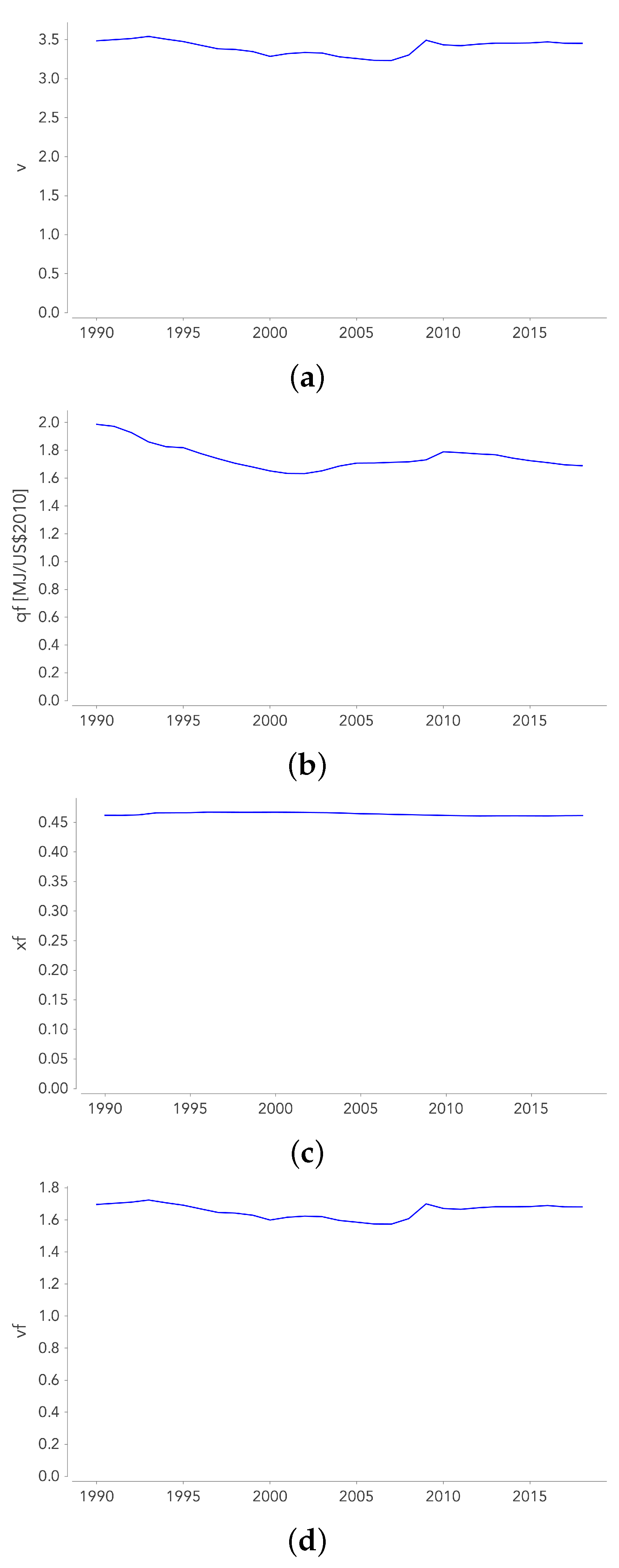
Appendix F. Future Evolution of Ye and qf
| 1990–2018 | 1990–1999 | 2000–2009 | 2010–2018 | |
|---|---|---|---|---|
| [%] | 1.63 | 1.02 | 2.05 | 1.16 |
| [%] | −0.58 | −1.85 | 0.56 | −0.72 |
| [%] | [%] | |
|---|---|---|
| BAU | 2.72 | 1.6 |
| SD | 0 | 7 |
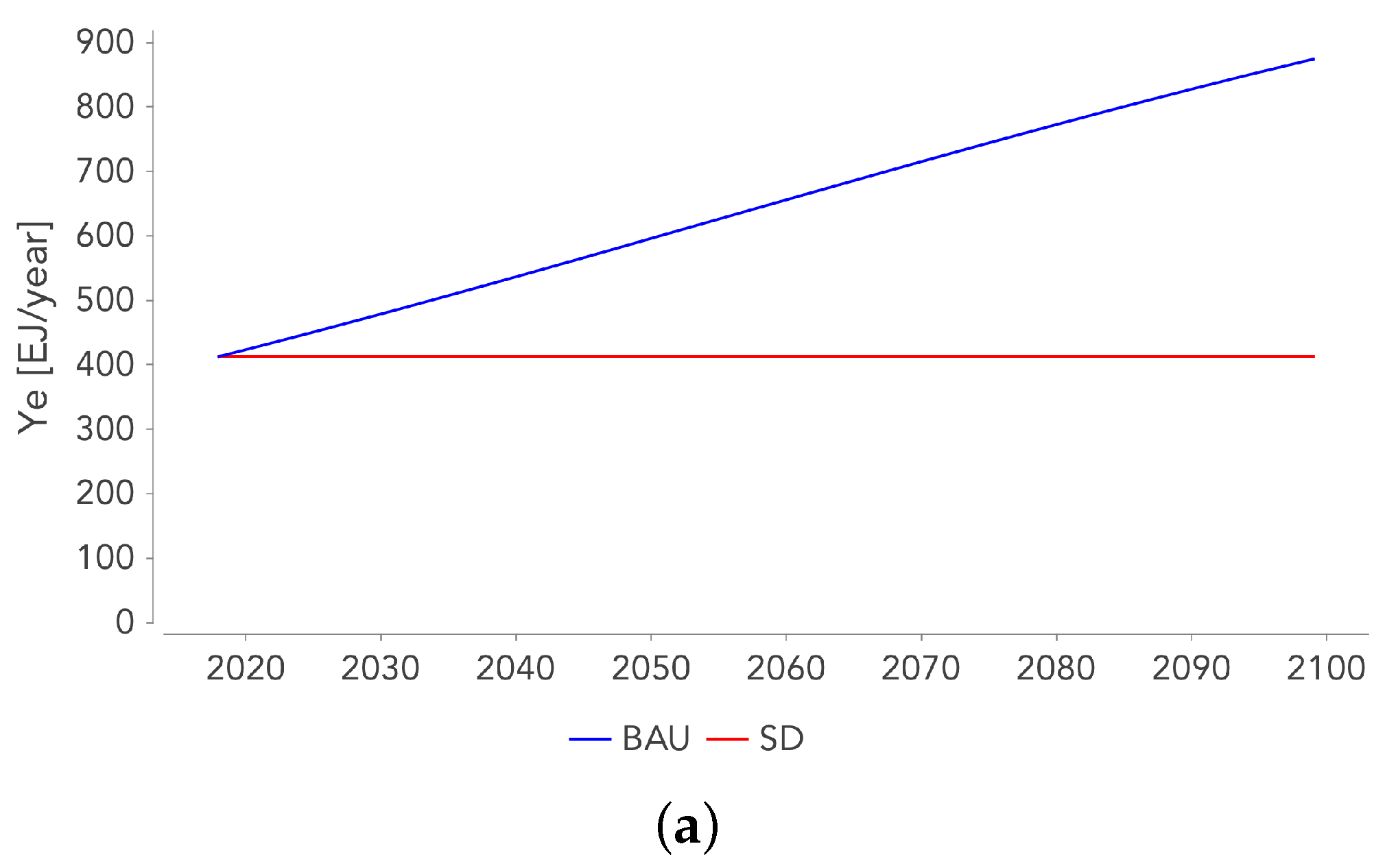
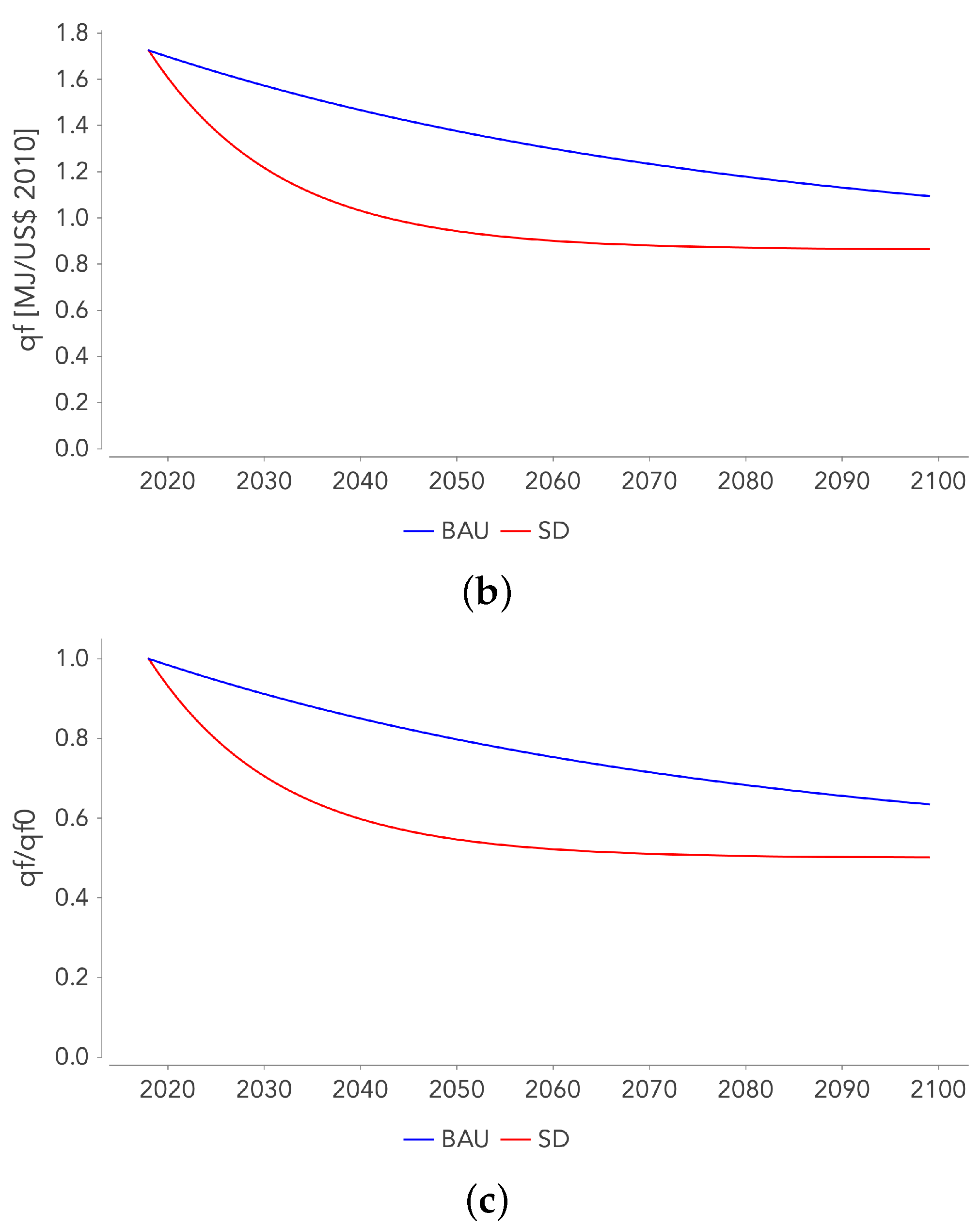
Appendix G. Link between v, g and gk
References
- Budischak, C.; Sewell, D.; Thomson, H.; Mach, L.; Veron, D.E. Cost-minimized combinations of wind power, solar power and electrochemical storage, powering the grid up to 99.9% of the time. J. Power Sources 2013, 225, 60–74. [Google Scholar] [CrossRef] [Green Version]
- Ellabban, O.; Abu-rub, H.; Blaabjerg, F. Renewable energy resources: Current status, future prospects and their enabling technology. Renew. Sustain. Energy Rev. 2014, 39, 748–764. [Google Scholar] [CrossRef]
- Jacobson, M.Z.; Delucchi, M.A.; Bazouin, G.; Bauer, Z.A.F.; Heavey, C.C.; Fisher, E.; Morris, S.B.; Piekutowski, D.J.Y.; Vencill, T.A.; Yeskoo, T.W. Environmental Science the 50 United States. Energy Environ. Sci. 2015, 8, 2093–2117. [Google Scholar] [CrossRef]
- Jacobson, M. 100% Clean and Renewable Wind, Water, and Sunlight All-Sector Energy Roadmaps for 139 Countries of the World. Joule 2017, 1, 108–121. [Google Scholar] [CrossRef] [Green Version]
- Jacobson, M.Z. Roadmaps to Transition Countries to 100% Clean, Renewable Energy for All Purposes to Curtail Global Warming, Air Pollution, and Energy Risk. Earth’s Futur. 2017, 5, 948–952. [Google Scholar] [CrossRef]
- Davis, S.J.; Lewis, N.S.; Shaner, M.; Aggarwal, S.; Arent, D.; Azevedo, I.L.; Benson, S.M.; Bradley, T.; Brouwer, J.; Chiang, Y.M.; et al. Net-zero emissions energy systems. Science (80-.) 2018, 360. [Google Scholar] [CrossRef] [Green Version]
- Ram, M.; Bogdanov, D.; Aghahosseini, A.; Gulagi, A.; Oyewo, A.; Child, M.; Caldera, U.; Sadovskaia, K.; Farfan, J.; Barbosa, L.; et al. Global Energy System Based on 100% Renewable Energy-Power, Heat, Transport and Desalination Sectors; Lappeenranta University of Technology and Energy Watch Group: Lappeenranta, Finland; Berlin, Germany, 2019. [Google Scholar]
- Bogdanov, D.; Gulagi, A.; Fasihi, M.; Breyer, C. Full energy sector transition towards 100% renewable energy supply: Integrating power, heat, transport and industry sectors including desalination. Appl. Energy 2021, 283, 116273. [Google Scholar] [CrossRef]
- Moriarty, P.; Honnery, D. Feasability of a 100% Global Renewable Energy System. Energies 2020, 13, 5543. [Google Scholar] [CrossRef]
- Capellán-Pérez, I.; de Blas, I.; Nieto, J.; de Castro, C.; Miguel, L.J.; Carpintero, O.; Mediavilla, M.; Lobejon, L.F.; Ferreras-alonso, N.; Rodrigo, P.; et al. MEDEAS: A new modeling framework integrating global biophysical and socioeconomic constraints. Energy Environ. Sci. 2020. [Google Scholar] [CrossRef]
- WWF. The Energy Report 100% Renewable by 2050; Technical Report; WWF: Gland, Switzerland, 2011. [Google Scholar]
- Nieto, J.; Miguel, L.J.; Blas, I.D. Macroeconomic modelling under energy constraints: Global low carbon transition scenarios. Energy Policy 2020, 137. [Google Scholar] [CrossRef] [Green Version]
- Sers, M.R.; Victor, P.A. The Energy-emissions Trap. Ecol. Econ. 2018, 151, 10–21. [Google Scholar] [CrossRef]
- Dupont, E.; Jeanmart, H.; Possoz, L.; Fagnart, J.F.; Germain, M. Transition Énergétique et (dé) Croissance Économique; Université Catholique de Louvain, Institut de Recherches Economiques et Sociales (IRES): Ottignies-Louvain-la-Neuve, Belgium, 2017. [Google Scholar]
- Dale, M.; Krumdieck, S.; Bodger, P. Global energy modelling—A biophysical approach (GEMBA) Part 1: An overview of biophysical economics. Ecol. Econ. 2012, 73, 152–157. [Google Scholar] [CrossRef]
- Dale, M.; Krumdieck, S.; Bodger, P. Global energy modelling—A biophysical approach (GEMBA) Part 2: Methodology. Ecol. Econ. 2012, 73, 158–167. [Google Scholar] [CrossRef]
- Fagnart, J.F.; Germain, M.; Peeters, B. Can the Energy Transition Be Smooth? A General Equilibrium Approach to the EROEI. Sustainability 2020, 12, 1176. [Google Scholar] [CrossRef] [Green Version]
- Court, V.; Jouvet, P.A.; Lantz, F. Long-term endogenous economic growth and energy transitions. Energy J. Int. Assoc. Energy Econ. 2018, 39. [Google Scholar] [CrossRef]
- Režný, L.; Bureš, V. Energy Transition Scenarios and Their Economic Impacts in the Extended Neoclassical Model of Economic Growth. Sustainability 2019, 11, 3644. [Google Scholar] [CrossRef] [Green Version]
- Rye, C.D.; Jackson, T. A review of EROEI-dynamics energy-transition models. Energy Policy 2018, 122, 260–272. [Google Scholar] [CrossRef]
- Dupont, E.; Koppelaar, R.; Jeanmart, H. Global available wind energy with physical and energy return on investment constraints. Appl. Energy 2018, 209, 322–338. [Google Scholar] [CrossRef]
- Dupont, E.; Koppelaar, R.; Jeanmart, H. Global available solar energy under physical and energy return on investment constraints. Appl. Energy 2020, 257, 113968. [Google Scholar] [CrossRef]
- Fagnart, J.F.; Germain, M. Net energy ratio, EROEI and the macroeconomy. Struct. Chang. Econ. Dyn. 2016, 37, 121–126. [Google Scholar] [CrossRef]
- Dupont, E.; Germain, M.; Jeanmart, H. Estimate of the Societal Energy Return on Investment (EROI). Biophys. Econ. Sustain. 2021, 6. [Google Scholar] [CrossRef]
- IEA. World Energy Outlook 2020; Technical Report; IEA: Paris, France, 2020. [Google Scholar]
- EIA. Annual Energy Outlook 2020; EIA: Washington, DC, USA, 2020. [Google Scholar]
- Capellán-Pérez, I.; de Blas, I.; Nieto, J.; de Castro, C.; Miguel, L.J.; Mediavilla, M.; Carpintero, O.; Rodrigo, P.; Frechoso, F.; Cáceres, S. Guiding European Policy toward a Low-Carbon Economy. Modelling Sustainable Energy System Development under Environmental and Socioeconomic Constraints. D4.1 (D13) Global Model: MEDEAS-World Model and IOA Implementation ot Global Geographical Level; Technical Report; Pg. Marítim de la Barceloneta: Barcelona, Spain, 2017. [Google Scholar]
- OECD. Input-Output Tables; OECD: Paris, France, 2015. [Google Scholar]
- Kümmel, R.; Lindenberger, D.; Weiser, F. The economic power of energy and the need to integrate it with energy policy. Energy Policy 2015, 86, 833–843. [Google Scholar] [CrossRef]
- Ayres, R.U.; van den Bergh, J.C.J.M.; Lindenberger, D.; Warr, B. The underestimated contribution of energy to economic growth. Struct. Chang. Econ. Dyn. 2013, 27, 79–88. [Google Scholar] [CrossRef]
- Court, V.; Fizaine, F. Energy expenditure, economic growth, and the minimum EROI of society. Energy Policy 2016, 95, 172–186. [Google Scholar] [CrossRef]
- IPCC. Global Warming of 1.5 °C; Technical Report; Intergovernmental Panel on Climate Change: Geneva, Switzerland, 2018. [Google Scholar]
- IEA. Key World Energy Statistics 2020; Technical Report August; IEA: Paris, France, 2020. [Google Scholar]
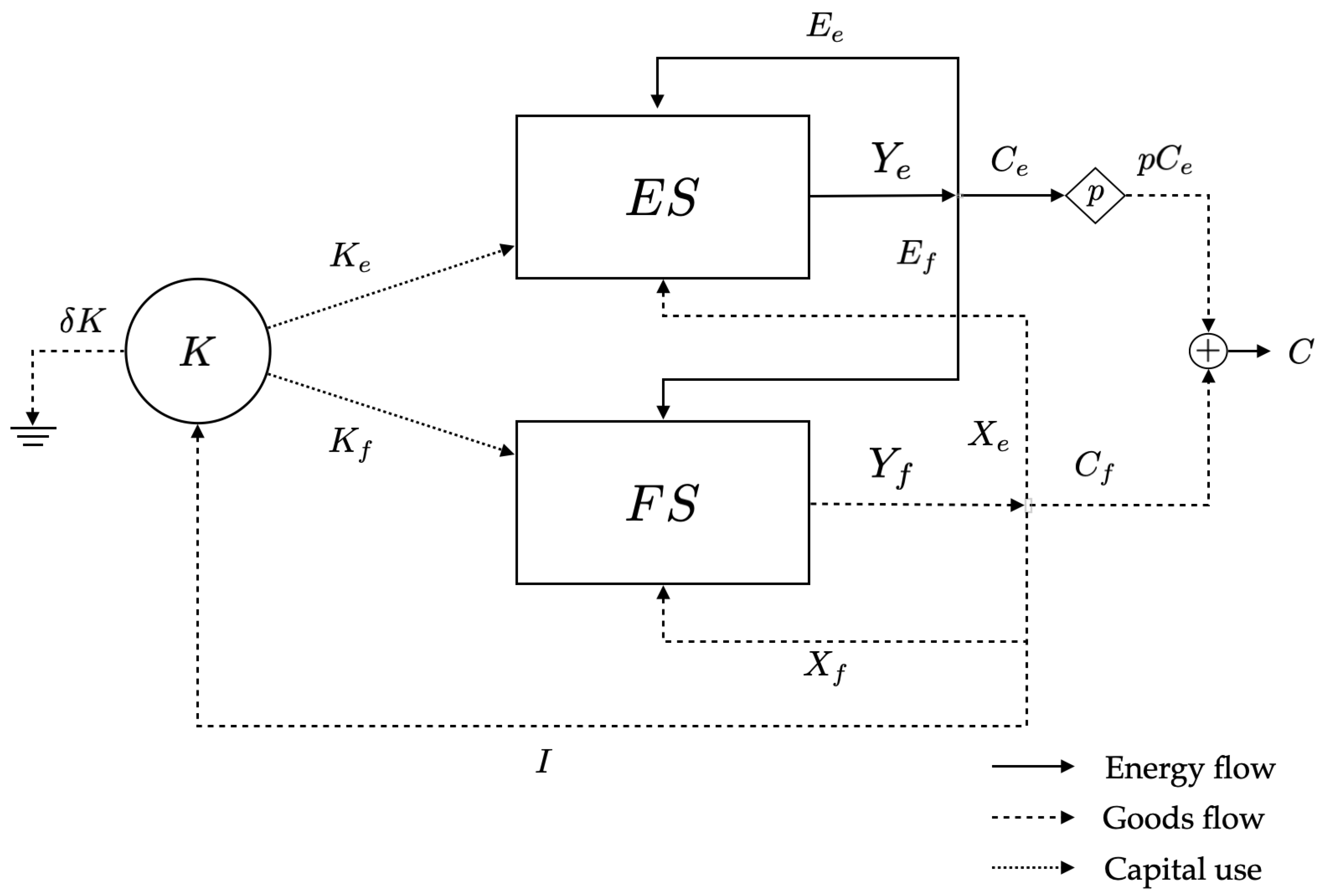

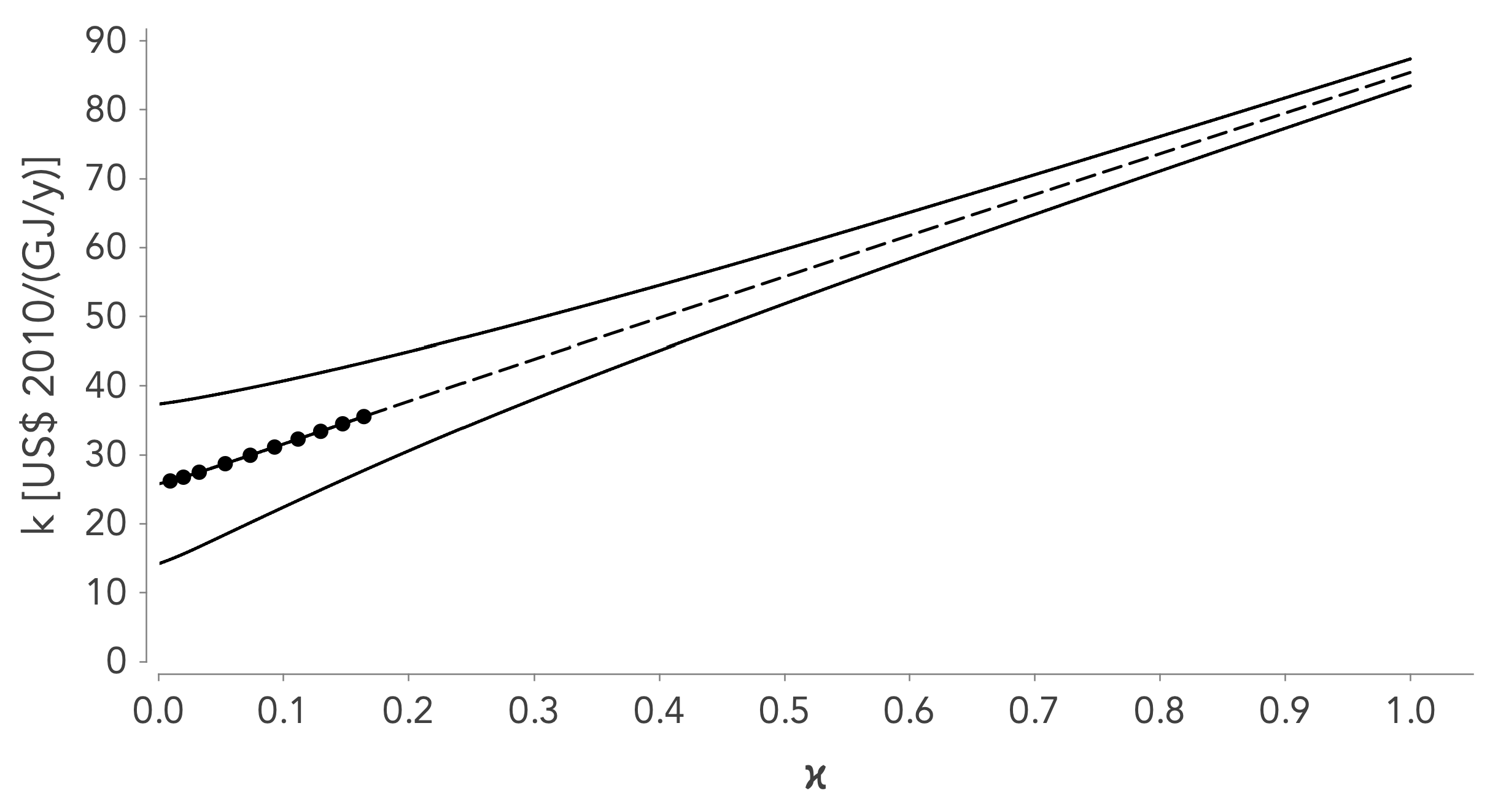


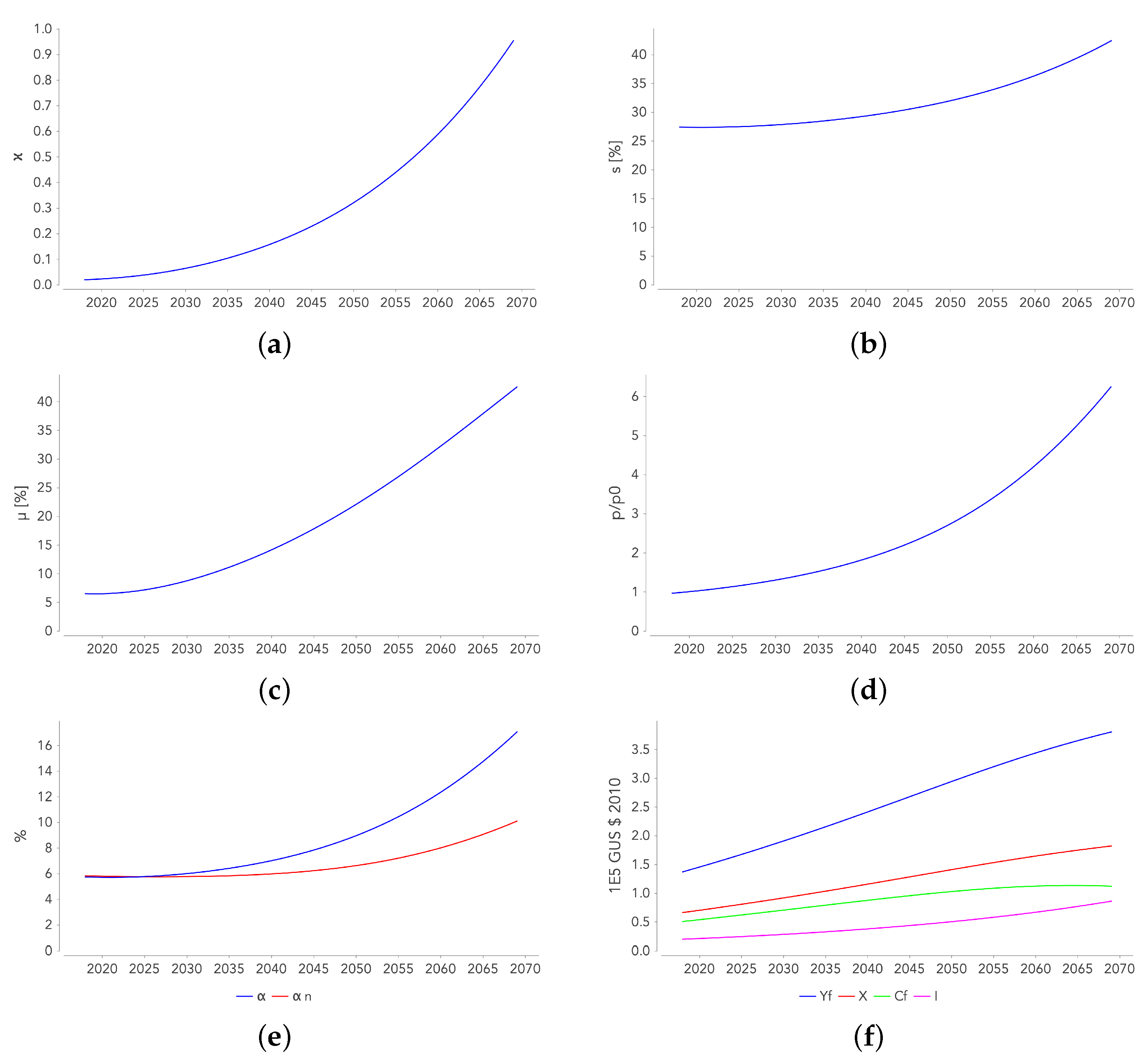
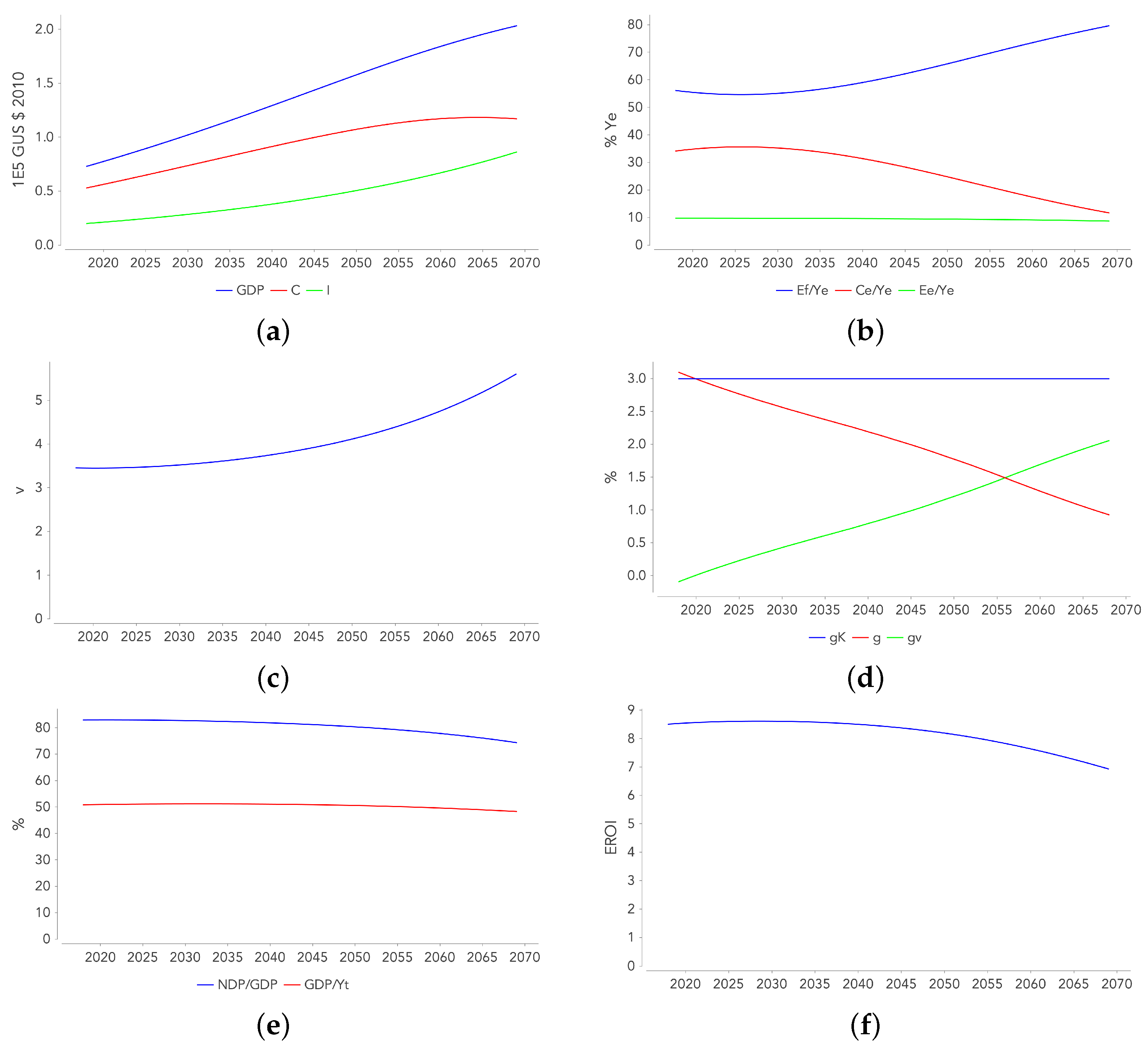
| [-] | 1.72 |
| [MJ/US$ 2010] | 1.7 |
| [-] | 0.47 |
| [US$2010/(GJ/y)] | 39.07 |
| [%] | 9.8 |
| [US$2010/GJ] | 3.32 |
| EROI [-] | 8.5 |
| Energy Sector | Non-Renewable Subsector | Renewable Subsector | |
|---|---|---|---|
| [%] | 9.76 | 9.78 | 8.68 |
| [US$2010/GJ] | 3.32 | 3.32 | 3.01 |
| [US$2010/(GJ/y)] | 39.07 | 26.65 | 647.63 |
| BAU | SD | |||||||||
|---|---|---|---|---|---|---|---|---|---|---|
| 2050 | 2100 | 2129 | 2050 | 2100 | 2133 | 2050 | 2085 | 2050 | 2090 | |
| [%] | 16.8 | 46.1 | 100 | 0 | 17 | 100 | 31.2 | 100 | 0 | 100 |
| s [%] | 29.8 | 34.8 | 44 | 24.4 | 25.9 | 41.1 | 30.7 | 40.1 | 23.9 | 36.8 |
| [%] | [%] | |
|---|---|---|
| 0 | 2.91 | 43.5 |
| 0.2 | 2.96 | 43.1 |
| 0.4 | 3 | 42.5 |
| 0.6 | 3.04 | 42 |
| 0.8 | 3.08 | 41.5 |
| 1.0 | 3.12 | 41.1 |
Publisher’s Note: MDPI stays neutral with regard to jurisdictional claims in published maps and institutional affiliations. |
© 2021 by the authors. Licensee MDPI, Basel, Switzerland. This article is an open access article distributed under the terms and conditions of the Creative Commons Attribution (CC BY) license (https://creativecommons.org/licenses/by/4.0/).
Share and Cite
Dupont, E.; Germain, M.; Jeanmart, H. Feasibility and Economic Impacts of the Energy Transition. Sustainability 2021, 13, 5345. https://doi.org/10.3390/su13105345
Dupont E, Germain M, Jeanmart H. Feasibility and Economic Impacts of the Energy Transition. Sustainability. 2021; 13(10):5345. https://doi.org/10.3390/su13105345
Chicago/Turabian StyleDupont, Elise, Marc Germain, and Hervé Jeanmart. 2021. "Feasibility and Economic Impacts of the Energy Transition" Sustainability 13, no. 10: 5345. https://doi.org/10.3390/su13105345
APA StyleDupont, E., Germain, M., & Jeanmart, H. (2021). Feasibility and Economic Impacts of the Energy Transition. Sustainability, 13(10), 5345. https://doi.org/10.3390/su13105345





